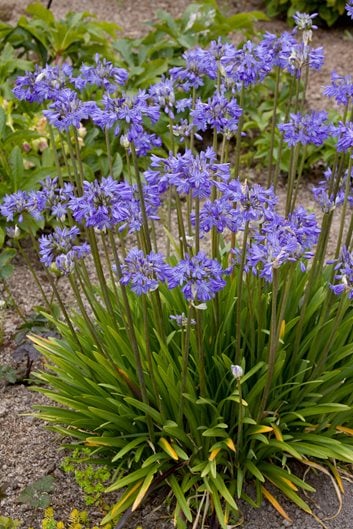Agapanthus Care Tips for Lush and Vibrant Flowers
Agapanthus Care Tips for Lush and Vibrant Flowers
Blog Article
Mastering the Art of Agapanthus Treatment: Vital Actions for Healthy Growth and Vibrant Blossoms
In the realm of gardening, the farming of agapanthus stands as a gratifying venture for those who seek to nurture these elegant flowering plants. With their striking blooms and elegant foliage, agapanthus has captured the focus of garden enthusiasts worldwide. However, achieving ideal growth and dynamic blossoms needs a nuanced strategy that encompasses numerous vital actions. From picking the appropriate variety to mastering trimming methods, the trip towards growing growing agapanthus plants is complex and holds the vital to opening the full capacity of these agricultural gems.

Picking the Right Agapanthus Variety

When picking the best Agapanthus variety for your garden, consider elements such as environment suitability, flower shade, and growth behavior. Furthermore, consider the environment in your region to guarantee the Agapanthus range you choose can thrive in your specific problems. Understanding the growth habit of various Agapanthus varieties is critical for proper positioning within your yard.
Perfect Growing Problems
Thinking about the optimum ecological requirements is vital for effective Agapanthus growing. Agapanthus plants are sensitive to cool temperature levels and must be protected from frost during winter season months.
To make sure healthy and balanced development and vibrant blossoms, plant Agapanthus bulbs at a deepness of regarding 2-4 inches and room them 8-12 inches apart. Adding natural issue, such as compost, to the dirt can boost water drainage and fertility, advertising durable root growth. Mulching around the base of the plants assists keep wetness and suppresses weed development. Routine watering is essential, especially throughout the expanding period, to keep the soil continually moist however not soaked.
Watering and Fertilizing Tips
Preserving appropriate moisture levels and supplying important nutrients are essential components in the care regimen for Agapanthus plants. When it comes to watering Agapanthus, it is essential to strike an equilibrium. These plants favor constantly moist dirt yet are susceptible to root rot if overwatered.
Feeding Agapanthus is crucial for promoting healthy and balanced development and respected blossoms. Use a well balanced plant food, such as a 10-10-10 formula, in the early springtime as brand-new development arises. Repeat this application every 6-8 weeks throughout the growing season. Stay clear of extreme fertilization, as it can cause lavish foliage at the expenditure of blooms. Always comply with the supplier's instructions for correct dilution and application techniques. By pop over to this web-site complying with these watering and fertilizing tips, you can guarantee your Agapanthus plants flourish and produce dynamic, lasting flowers.
Pruning Methods for Agapanthus
Trimming Agapanthus plants at the proper times and with proper methods is critical for maintaining their health and promoting ideal growth and blooming. The suitable time to trim Agapanthus is in late winter or early springtime prior to new development emerges.
For flowered stems, wait till the blooms have actually perished and after that trim them back to the base. This not just cleans up the plant's appearance yet also urges the advancement of brand-new flower buds. Deadheading spent flowers can additionally redirect the plant's power right into producing even more blooms dig this instead of setting seeds. Nonetheless, if you wish to collect seeds for breeding, leave some flowers to mature and completely dry on the plant.
Bear in mind to use tidy, sharp tools to make exact cuts and reduce the threat of presenting diseases. Agapanthus. Routine pruning will certainly aid maintain your Agapanthus looking healthy and balanced and neat while ensuring an abundant screen of attractive blossoms
Handling Usual Pests and Conditions
After ensuring correct trimming methods for Agapanthus, it is important to deal with usual bugs and conditions that can influence the health and wellness and vitality of these plants. Agapanthus plants are generally sturdy but can still succumb to particular problems. One common insect that affects Agapanthus is the Agapanthus gall midget. This little, orange fly lays its eggs in the foliage, bring about distorted growth and flower buds that stop working to open. To combat this bug, trim and damage any kind of damaged plant parts and take into consideration utilizing insecticidal soap.
In addition, Agapanthus plants can suffer from root rot if they are planted hop over to here in poorly draining pipes dirt. By being watchful and taking timely activity versus bugs and illness, you can assist your Agapanthus plants flourish and create vivid blossoms. Agapanthus.

Verdict
Finally, mastering the art of agapanthus care entails choosing the ideal range, providing excellent planting conditions, appropriate watering and fertilizing, suitable trimming techniques, and attending to common bugs and diseases. By following these vital steps, you can ensure healthy and balanced growth and dynamic flowers for your agapanthus plants. Remember to consistently monitor and keep your plants to promote their general well-being and long life.
To make certain healthy growth and vibrant flowers, plant Agapanthus light bulbs at a deepness of concerning 2-4 inches and space them 8-12 inches apart. By following these watering and fertilizing pointers, you can ensure your Agapanthus plants flourish and create lively, durable blossoms.
One usual insect that influences Agapanthus is the Agapanthus gall midget. Furthermore, Agapanthus plants can endure from root rot if they are grown in improperly draining dirt. By following these essential steps, you can ensure healthy and balanced development and vivid flowers for your agapanthus plants.
Report this page